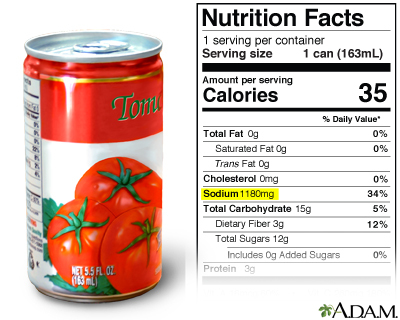Thanksgiving and your taste buds
Ready to carve that turkey and dig into a slice of pumpkin pie slathered with whipped cream? Maybe the broccoli casserole and sweet potatoes sound more…

Update your location to show providers, locations, and services closest to you.
Sodium is an element that the body needs to work properly. Salt contains sodium.
Diet - sodium (salt); Hyponatremia - sodium in diet; Hypernatremia - sodium in diet; Heart failure - sodium in diet
The body uses sodium to control blood pressure and blood volume. Your body also needs sodium for your muscles and nerves to work properly.
Sodium occurs naturally in most foods. The most common form of sodium is sodium chloride, which is table salt. Milk, beets, and celery also naturally contain sodium. Drinking water also contains sodium, but the amount depends on the source.
Sodium is also added to many food products. Some of these added forms are monosodium glutamate (MSG), sodium nitrite, sodium saccharin, baking soda (sodium bicarbonate), and sodium benzoate. These are in items such as Worcestershire sauce, soy sauce, onion salt, garlic salt, and bouillon cubes.
Processed meats like bacon, sausage, and ham, along with canned soups and vegetables also contain added sodium. Processed baked goods such as packaged cookies, snack cakes, and doughnuts, are also often high in sodium. Fast foods are generally very high in sodium.
Too much sodium in the diet may lead to:
Sodium in the diet (called dietary sodium) is measured in milligrams (mg). Table salt is 40% sodium. One teaspoon (5 milliliters) of table salt contains 2,300 mg of sodium.
Healthy adults should limit sodium intake to 2,300 mg per day. Adults with high blood pressure should have no more than 1,500 mg per day. Those with congestive heart failure, liver cirrhosis, and kidney disease may need much lower amounts.
There are no specific sodium restrictions for infants, children, and teens. However, certain levels of daily adequate intake for healthy growth have been established. These include:
Eating habits, taste, and attitudes about food that are formed during childhood are likely to influence food choices for life. For this reason, it is a good idea for children to avoid consuming too much sodium.

Appel LJ. Diet and blood pressure. In: Bakris GL, Sorrentino MJ, eds. Hypertension: A Companion to Braunwald's Heart Disease. 3rd ed. Philadelphia, PA: Elsevier; 2018:chap 21.
Eckel RH, Jakicic JM, Ard JD, et al. 2013 AHA/ACC guideline on lifestyle management to reduce cardiovascular risk: a report of the American College of Cardiology/American Heart Association Task Force on practice guidelines. Circulation. 2014;129(25 Suppl 2):S76-S99. PMID: 24222015 pubmed.ncbi.nlm.nih.gov/24222015/.
Mozaffarian D. Nutrition and cardiovascular and metabolic diseases. In: Zipes DP, Libby P, Bonow RO, Mann, DL, Tomaselli GF, Braunwald E, eds. Braunwald's Heart Disease: A Textbook of Cardiovascular Medicine. 11th ed. Philadelphia, PA: Elsevier; 2019:chap 49.
The National Academies of Sciences, Engineering, and Medicine website. 2019. Dietary Reference Intakes for Sodium and Potassium. Washington, DC: The National Academies Press. www.nap.edu/catalog/25353/dietary-reference-intakes-for-sodium-and-potassium. Accessed June 6, 2022.
Ready to carve that turkey and dig into a slice of pumpkin pie slathered with whipped cream? Maybe the broccoli casserole and sweet potatoes sound more…

April 30, 2015
Oxytocin is best known as the “love hormone” that is released during a hug or a kiss. Now, two University of Florida College of Pharmacy researchers have been…
College of Pharmacy, +1 more